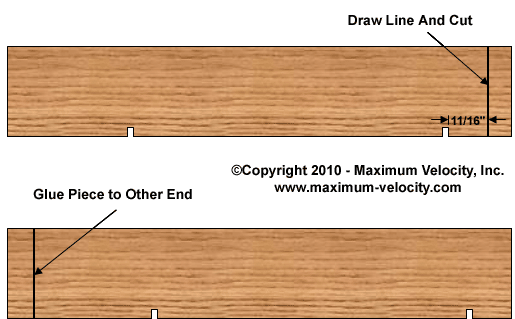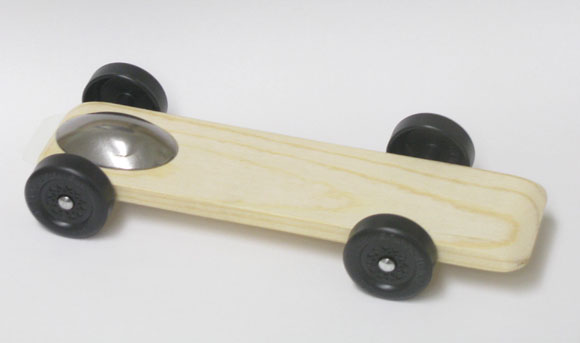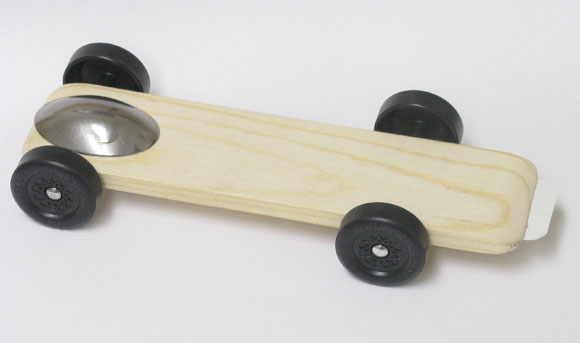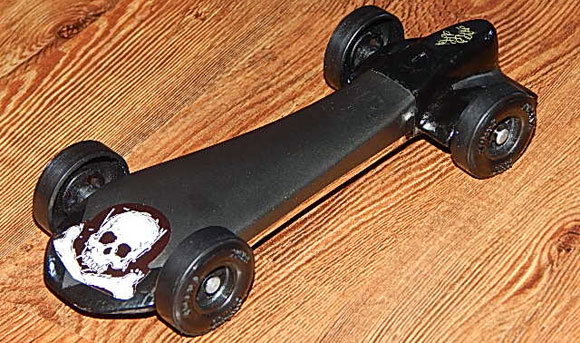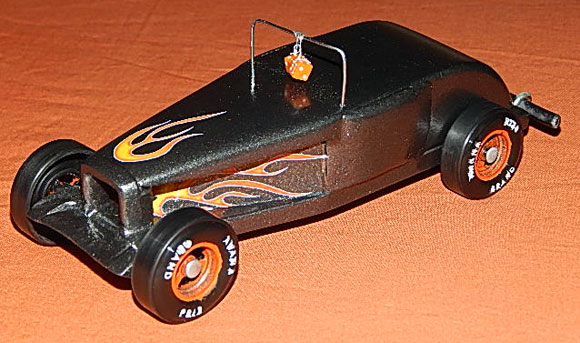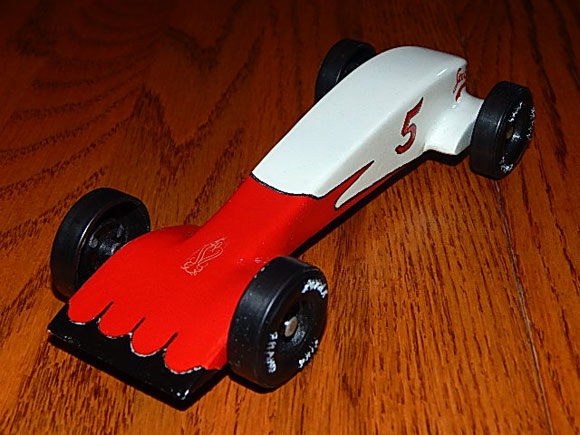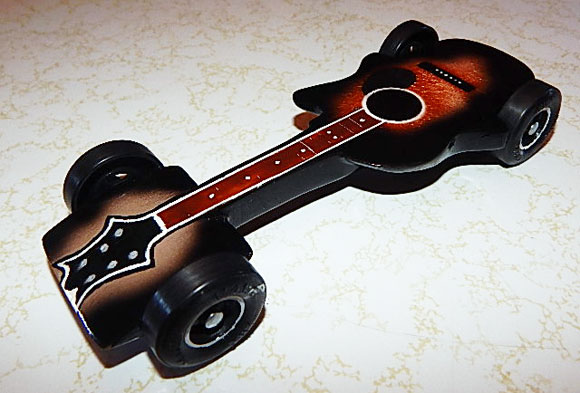– Feature Article – Shifting the Wheelbase
– Humor
– Pinewood Derby Car Showcase
– Q&A
Feature Article
Shifting the Wheelbase
By Randy Davis
The standard pinewood derby kit from BSA (as well as PineCar and Maximum Velocity), has an offset wheelbase, with one slot approximately 1-3/4 inches from the end of the block, and the other slot approximately 1 inch from the end of the block. The 1 inch slot is generally used as the rear axle, as this places the rear axle as far up the hill as possible, thus allowing the center of gravity (COG) of the car to be as far up the hill as possible.1
Some races do not place restrictions on the wheel base, thus allowing the builder to extend the wheelbase by moving the rear axle back and the front axle forward. Other races place restrictions on both the location and position of the wheelbase, thus preventing any adjustment to the wheelbase.
But some races restrict the distance between the front and rear axles, but do not place a restriction on the location of the front and rear axles. In this case, the wheel base can be shifted to potentially gain an advantage (see Figure 1). But does this really provide an advantage, and if so, how much advantage is attained? Let’s find out.
Figure 1 – Shifted wheelbase
Methods To Shift The Wheelbase
There are several ways to shift the wheelbase:
- If axle holes are allowed in your race (as opposed to requiring the use of axle slots), then new axle holes can be drilled with a Pro-Body Tool, Pro-Body Jig, or with a drill press.
- If axle slots are required, then new slots can be cut with a Pro- Body Slotter.
- If the original slots must be used, then a piece of the block can be cut off the back and glued to the front. (See Figure 2).
Figure 2 – Shifting the Wheelbase While Retaining the Original Slots
Experiment Setup
In our experiment, we want to avoid changing any factor that would affect the performance of the car, other than the shifted wheelbase. So we will leave the original wheelbase intact, and effect the shift by moving a part from the back of the car to the front of the car. (See Figure 3).
Figure 3 – Test Car
(Note the polystyrene piece at the back of the car in the first photo, and the front of the car in the second photo)
The body of the test car was shortened by 1/4 inch, and then a thin slot was cut crosswise on both the front and back of the car. A piece of polystyrene was cut such that when installed into one of the slots, the car measures seven inches long. By moving the polystyrene between the front and back of the car, the wheelbase is shifted by 1/4 inch without changing any other factor on the car.2
The car is equipped with polished speed axles and Pro-Stock Speed Wheels, and is lubed with Krytox 100. The car has a raised front left wheel, and is aligned to rail-ride. A 3.5 ounce tungsten canopy provides the majority of the weight, with a small amount of tungsten putty (in holes behind the rear axle) to bring the total weight up to five ounces. The COG of the car is 7/8 inch in front of the rear axles.
Five heats were run with the polystyrene piece at the back of the car (standard wheelbase), then ten heats were run with the polystyrene piece at the front of the car (shifted wheelbase). Finally, five heats were run with the polystyrene piece at the back to even out the heats to ten in each position.
Results
Standard Wheelbase Average – 2.542 sec; Std. Deviation – .0016 Shifted Wheelbase Average – 2.539 sec; Std. Deviation – .0008
The data shows an improvement in time with the shifted wheelbase of .003 seconds. This is more than the standard deviation, so the difference is statistically significant.
Conclusion
Going into the experiment I expected an improvement from the shifted wheelbase, but I expected the improvement to be more than 3 ms. It is possible that the improvement due to the wheelbase shift would be larger if other factors could be minimized. For example, if disk (outlaw-type) wheels were used, the improvement due to the shifted wheelbase may be amplified.3
1More information on modifying the wheelbase can be found in Volume 10, Issue 13.
2The main issue with an experiment of this kind is that moving material from the back to the front changes the COG of the car. The advantage to the polystyrene piece is that the change is negligible since the polystyrene weighs less than 1/10th of a gram.
3I’ve added this to my list of future experiments.
Humor
Great Truths That Adults Have Learned
- Raising teenagers is like nailing Jell-O to a tree.
- Wrinkles don’t hurt.
- Families are like fudge … mostly sweet, with a few nuts.
- Today’s mighty oak is just yesterday’s nut that held its ground.
- Laughing is good exercise. It’s like jogging on the inside.
- Middle age is when you choose your cereal for the fiber, not the toy.
Pinewood Derby Car Showcase
Today’s cars were submitted by Bob Tachick.
Pirate Sword
This is my son’s second car, and was supposed to look like a sword, although the handle in back ended up getting packed with tungsten cubes.
It has a set screw threaded into the wood on top for adding a few extra BBs or such at the weigh-in, while still keeping the lines clean for air flow.
This car won by less than a hundredth of a second to spare; it also raced at our local Home Depot race and with some minor adjustments and more polishing took first place the second year. It’s all about details.
’32 Deuce Coupe
This car required a lot of cutting and hollowing out, but was worth the effort. It was a big hit with the car guys at church, as a lot of cars are left on display for the week end. The body was cut off the frame, the whole inside was cleaned out, the engine compartment was removed, and balsa wood panels in a wedge shape split the air up front and allowed a flame job on the side of the car. The windshield is simply a paper clip to give the impression; but this car is smooth with clear coat and wax. My son did most of the wood work, as well as the running gear, and paint; this was his 3rd car.
“The Fonz” would have liked this car, it brought home the first place trophy.
Gee Bee Sportster
This car is designed as I think the Granville Brothers would have done based on their 1931 and ’32 airplanes, the Gee Bee’s.
The body is cut down to just enough wood to accommodate a wedge front end and the axles. The car has a hollow center section, a stack of tungsten cylinders in the rear and an airfoil for the rear axles. The tail is designed to not create any turbulence and eliminate drag. I let my wife race this one in the open class, and it easily took first, turning in the same time as my son’s 1st place car that day.
Guitar
I built this car for my daughter who never had the privilege of club racing; I thought she should race at least once before going to college.
This is designed to look like her guitar, the shape and color which required airbrushing – something new for me.
Design features include an aggressive balance point, a flat top with airflow directed under the rear instead of over, and lots of attention to detail including polishing everything. The body, wheels and axles only weighed an ounce before adding the weight and paint.
Try as she might, she couldn’t get it to slow down and was a bit embarrassed beating the guys. She set a new household record, and I believe a new track record.
Q&A
I was wondering if you sell prepared wheels to fit your bearings, or even better do you sell the wheels attached to the bearings?
Sorry, we don’t have wheels for the bearings. However, if you are building a pinewood derby car to weigh 5 ounces, then the Needle Axle Wheels with the upgraded axles will be just as fast as bearings and are much easier to install.
The Needle Axle Wheels can be found Here (part 4042 or 4043).
The Needle Axle Upgrade Kit can be found Here (part 4049)
I have the Pro-Body Tool and was planning on drilling axles holes instead of using the slots. I read in one of your newsletters this can be better for alignment. Any tips for putting the axles into the holes correctly? Or should I just use the slots and the pro body tool? I am assuming if the holes are drilled correctly the axles will go in straight.
You can use the Pro-Body Tool to pilot-drill the existing slots, or drill new axle holes. In either case, the axles will follow the path of the drill bit.
After using the Pro-Body Tool, I would press a spare axle into an axle position, and twist and pull it out with a pair of pliers. Repeat for the other three positions. When painting, put round toothpicks into the axle positions. Then when you insert the real axles, they should just press in easily.
I coated the axle with tungsten disulfide and coated the bore with Max-V-Lube. I ran the car twice on a track. I was thinking of lubing the car with Hob-E-Lube with moly. What are your thoughts about mixing lubes?
You can mix graphite brands if you want. However, I am not a fan of tungsten disulfide or molybdenum. Both molybdenum (and tungsten) are very hard metals, and the small particles in the lube scratch up the surface of the polished axles.
Back Issues
Are you a new subscriber, or have you missed some of the previous newsletters? Don’t miss out; all of the issues for Volume 5 through Volume 17 are posted on our web site.
Newsletter Contributions
We welcome your contributions. If you would like to contribute an article, a web site review, a speed tip, or a pinewood derby memory, please e-mail us.
Subscription Information
The Pinewood Derby Times is a free e-newsletter focused on pinewood derby racing. It is published biweekly from October through March.
If you haven’t already done so, please forward this issue to your pinewood derby friends. But please don’t subscribe your friends. Let them decide for themselves. Thanks.
If this newsletter was forwarded to you, why not subscribe to receive this newsletter. There is no cost, and your e-mail address is safe, as we never sell or share our distribution list.
To subscribe, send a blank e-mail to
pi*********************@*******st.com
You will receive a confirmation e-mail. Reply to the confirmation e-mail and you will start receiving the Pinewood Derby Times with the next issue.
Randy Davis, Editor, Pinewood Derby Times
E-Mail: in**@**************ty.com
(C)2019, Maximum Velocity, Inc. All rights reserved. Please do not reprint or place this newsletter on your web site without explicit permission. However, if you like this newsletter we grant permission, and encourage you to e-mail it to a friend.
Maximum Velocity disclaims any personal loss or liability caused by utilization of any information presented in this newsletter.
The Pinewood Derby Times is not specific to, and is not affiliated with the Boy Scouts of America, YMCA, Awana, or any other organization.
(R)Maximum Velocity is a registered trademark of Maximum Velocity, Inc.
(R)Pinewood Derby is a registered trademarks of the Boys Scouts of America.
(R)Awana is a registered trademark of Awana Clubs International.
All other names are trademarks of their respective owners.


